What a just plain fantastic time of year this is. Things are starting to warm up and the vines will be budding any moment now. And with that warm air comes some of my favorite American activities. Baseball and BBQ are starting to get going. And nothing goes better with those activities than Zinfandel. Well, I won’t get carried away here. A solid pint of beer goes down with those two perfectly as well. I’ve been enjoying some Pliny The Elder along with my usual Anchor Steam and local favorite Firestone Double Barrel. But the Paso Robles Zin fest is here this weekend and Paso Robles Adult Co-Ed softball season kicks off, so I’m sticking with Zin, Tri-Tip, and Bat and Glove for today.
Don’t know if you missed this, but Paso has a new attitude about its Zinfandel bona fides. Here is the ad the area pitched in to produce hyping up our Zinfandel production. Note the baseball reference in there as well.
When people talk of “food friendly” wine, it seems they are rarely talking about Central Coast BBQ. It may not be proper French cuisine, but it is food. And damn good food at that. And it pairs with big Paso Zins like nothing else. It reminds me of my basic pairing rule, pair flavors from the same region. Here in Paso, we like to cook big slabs of meat on top of oak fires with plentiful sauce. This produces a meal filled with richness, smoke, and decadence. If you want your wine to match up, put the German Riesling away and grab some Paso Zin. Our 2007 Zin will go on sale for the last time this weekend; it is the official drink of my backyard right now.
And for a final thought, I just want to hype up my trusty softball glove that I oiled up last night. Getting out the old leather after a few months just brings back all those great memories of getting excited for little league and pick up games as a kid. There really is nothing quite like the smell and feel of oiling a perfectly broken in mitt as an American ceremony for saying good riddance to winter. Perusing the local sporting good store recently though, I was a bit saddened at the condition of the baseball/softball mitt world. For one, nothing I could find in this area was made in America. And worse, all the leather felt thin and stiff, none of the life you want from a good glove. So if you play, or are in the market for something for a kid just starting out, do yourself a favor and check out Nokona. Nokona is the last company that hand makes gloves in America for America’s pastime. They are simply an amazing product that is in a class all by itself. They even have gloves made of bison if you want to get truly USA all the way. Like the wine I make, and the barrels I use, they strive to be hand made works of art.

There really is no way of describing the difference in feel between one of these gloves and the usual store bought one you find at Wal-Mart or wherever. It just feels right, heavier duty in everyway, but much more supple at the same time. You will want to just go play catch the second you put it on. So get out there, winter is receding and spring is in the air. Goodtimes!
Oh and how could I forget....
One of the things that connects me most to winemaking at a small family owned winery like Calcareous is the handmade nature of the product. All work done on the vines is done by hand. The fruit is hand picked. And in the winery during crush, the wine making here is defintely hands on. Which all comes to mind this time of year when meeting with the salespeople and coopers from the cooperages that make the barrels we use. Although for simplicity reasons we often categorize the oak used in wine making as French, American or European, reality is much more interesting than that. After all, do we just lump in all grapes as being either French, Spanish or Italian?
Making barrels is just as much an ancient artisian craft as wine making. Each barrel is hand made and toasted by some one with oak staves, steel hoops, a hammer, and a fire pit in the ground. The way the flavors of the barrel integrate with the wine and the life the wine lives while aging are much more influenced by the person who made that barrel than by just where the tree was grown. In recent years, the barrels of Tonnellerie Meyrieux have become one of my favorites and used in both my Rhone and Bordeaux programs. There might even be an expansion into the world of Pinot Noir.
If you are ever on a cellar tour and see this logo, you can impress the tour leader and fellow "tourists" (is that the proper word?) with the question "So how do you feel the powerful Meyrieux (pronounced May-Roo) barrels impact the wines made here?"
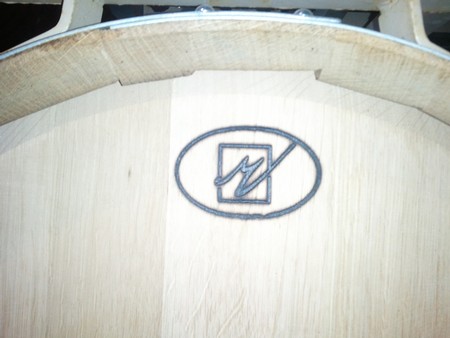
Powerful is the key word here. From 2007-2009 these barrels were only allowed to interact with Syrah, the power king of West Side Paso Robles. The method used for toasting these barrels produced wonderful flavors that softness to powerful wines like no other barrel I have ever used. As you can see here, the "House Toast", basically the toast the cooper feels is the best expression of their barrel, is made with Syrah in mind.

A house with the word Syrah is a foolproof way to tell the sleep deprived english speaking wine maker what to do with this barrel. Last year, after talking with the cooper and requesting a special lower temperature, longer timed toasting regiment, these barrels moved into Cabernet, Merlot and Petit Verdot. And after tasting through the barrels with him this past week, we were both very pleased with the outcome. This year he even had a new brazier designed that will allow an even milder yet deeper toast to the barrel.
This has led me to expectation of expanding the Meryrieux usage out to other varietals. Cab Franc, Pinot Noir (Meyrieux is located in Villers-La-Faye France after all), maybe even get crazy and put some Marsanne in one. We'll see. But one can not underestimate the importance of tailoring your barrel program to your wine making. And remember to thank the word's hard working artisan barrel makers the next time you taste perfect aging and oak integration in your glass.
After 10 days of rumors and building excitement, it actually happened. Honest to goodness snowfall here at Calcareous. This happens maybe every 2-3 years, we get a bit of a dusting. But this one was a bit more exciting. Actual winter like conditions descended upon the vineyard this past Saturday. The temperature was 31, dropping all the way down to 25 overnight. That is some serious stuff for Central Coast California. We like our February's in the mid 60's and sunny.
But as you can see, everyone was quite excited to see some snow on the ground.
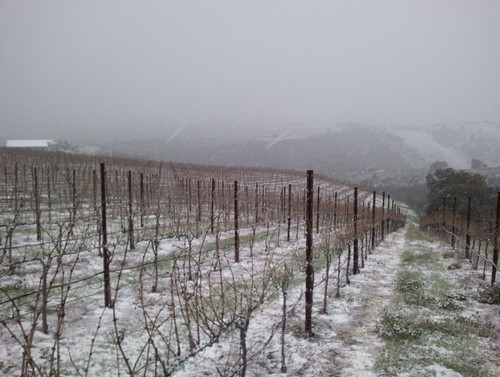
The vines are still dormant, so the cold temps were worry free for any budding that could take place. I was excited about the snow as a test of a little theory of mine. One about vines that, like people, those with more intense life experiences produce much interesting fruit of their labor. (Maybe I've been hanging out with the vines a bit too much as the anthropomorphisms are getting a bit too common.) Anyway, in my world this Cab Sauv vine is going to write a postcard to a cousin in France with the quick note "It's not all sunshine, beaches and easy living here in California!"
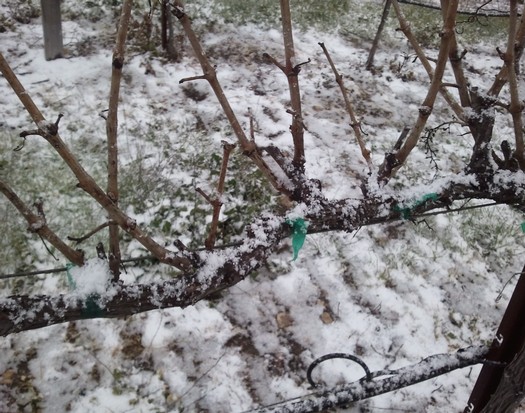
And like any excited snow novice who does not have to worry about shoveling the driveway, or getting to work on icy cold mornings, we made a nice little snowman/deer thing on our picnic table.

The only people that were not overjoyed were the possible picnic basket types who made their way up to our grounds to enjoy the view. Not too cozy out there for the wine and cheese snacking.

The tasting room though was warm and filled with customers hopeful that perhaps they would get snowed in and be forced to stay warm by drinking Cabernet and Syrah all night. Luckily for us all, this did not come to pass.
Last night I hosted a Cabernet Franc tasting for the San Luis Obispo chapter of the American Wine Society. A nice little event that allowed me the pleasure of standing in front of the group and waxing poetic on what ever came to mind.
Whenever I am involved in a tasting that is going to be varietal based, I like to find an example that is "typical" of the varietal. Well, what's supposed to mean? Basically, when people stopped just drinking wine and decided they needed to write about it as well, where was that varietal grown and produced most commonly. Then general description of the varietal will be based on how it expresses itself from that region. Be it Pinot Noir from Burgundy or Viognier from the Rhone. In this case, I walked into our local wine shop, 15˚C, and asked for a Loire Valley red in the $15-$20 range. They supplied me with exactly what I was looking for, a 2009 from Bourgeil. It had the light body, high acid, clean drying tannins and herbaceous flavors that one would expect from a Cab Franc. The interesting part was that all 9 wines we would go on to blind taste were examples from the California Central Coast, and they would only have a passing resemblance to the Bourgueil.
It is quite vogue these days for people to talk about terroir and its importance to wine. There is no doubting that the place where the wine is produced has a massive impact on the final product. And tasting these 10 wines, I began to believe that terroir perhaps has the most important impact. Is Cab Franc known for high acid, light body, herbal aromas and bright red fruit character because of DNA, or because that is how it expresses itself in the Loire? The California wines were all of darker color, heavier aroma and more filling body. These were no California Cab Sauv fruit pies have you. The color had more reds than purples (even young), and there was still herbal flowery aromas, strong acid back bones, and firm tannins on the better examples. What really impressed me was the sensation that the better California wines achieved balance.
I'm now convinced that veteran wine critics haze the rookies by telling them their first big assignment is to go taste all the Loires. Much respect to anyone who's mouth is still functioning after tasting about 10 of this acid machines. When tasting the Bourgueil, the acid and drying tannins really stood out. They were much stronger features than the aroma, the mid-palate fruit or the finish. This to me is the basic concept of out of balance, where one feature of the wine really sticks out and carries the whole tasting experience. Think of a Chardonnay where all you can taste is oak. The wines I most appreciated during the blind tasting had a full rich nose, a wonderful bright acid fore-palate that moved into red fruits and clean firm tannins. The full nose prepared you for the the brightness of the acid, which was then balanced by the fruit and tannins, thus creating a wine with a harmonious drinking experience.
I would say that these California wines were a perfect example of what Cab Franc tastes like. Sure, some critics would balk at this. But here in Paso Robles, it is not only impossible, but pointless to produce a Bourgueil or Chinon style Cab Franc. The soil, the weather, the philosophy, and goals of the vineyard are drastically different. Thus the wines have to be different as well. To attempt copying a style not your own is pure folly. Is one wine a truer expression of Cab Franc? A silly question, for all we can do is present the wine as it expresses itself from where it was grown.
This time of year, things are a bit slow and predictable in the cellar. The usual week consists of a blending trial here or there in preparation for the spring bottlings. Some topping and checking of SO2 levels is sure to follow. It’s a good time to do barrel evaluations in preparation for the onslaught of barrel salesmen coming in March. And finally, keep tracking malolactic fermentation of the 2010 wines. So, not much too really talk about in a picture page format as far as cellar activities. If you doubt me, well, here is the chromatography.
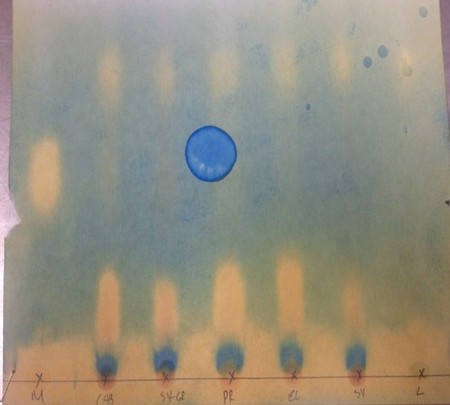
Never mind the big drop of DAP there in the middle, I got a bit too excited. Looks like the Estate Grenache, Block 6 Syrah, and maybe the Glen Rose Syrah are ready to go. Yeah, that’s the stuff of award winning blogging eh?
So instead, I’d like to talk a little about something else happening right now that has a massive impact on wine quality for 2011. We started pruning the vines last week. The way a vine is pruned is the first step you take in influencing the fruit of the next vintage. Pruning basically outlines how much fruit we want each vine to produce, while also limiting the amount of energy used in vegetative growth. Here is what the now dormant vines look like; this is Malbec in case you were wondering.
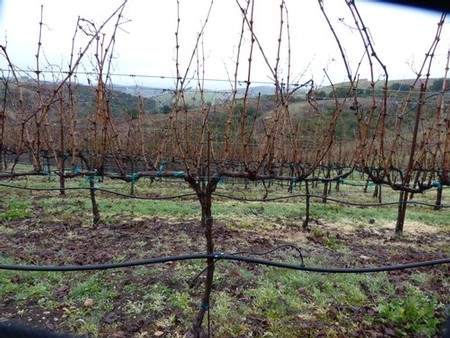
(These vines were planted in 2002! Things grow slowly on limestone.)
Ah, the blank canvas for the pruning shears. It’s time to get to work creating a grape producing masterpiece. Once we are finished, it should look something like this.
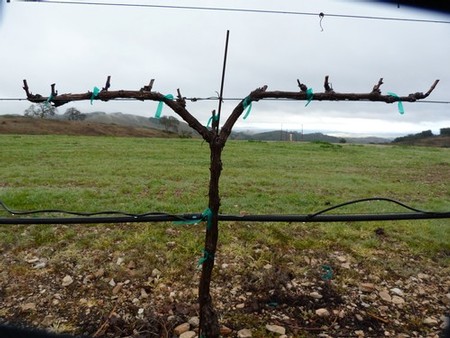
Well, sure, it looks like we hacked away at the thing to leave a vine with a bunch of little stubs. But there is quite a bit of thinking that goes into this. The first time I had to prune I was worthless. I stared, measured, counted my fingers, talked to the vine, everything to make the perfect prune. I was slow to the point of just being in the way. And to top it off, even with all my science and thinking, I was still making bad decisions. After a couple of hours though, the Zen of pruning begins to set in. The points where it is best to clip start to organically appear to you. I’m still no Edward Scissorhands like our vineyard manager Martin, but I can hold my own now.
For the home ranch, we use a cordon training system. The central vertical trunk splits into two permanent horizontal parts. This horizontal part is called the cordon. On the above photo, there are 5 nubs on each side of the cordon. Those nubs are the permanent spur positions, the locations where we will allow the yearly vegetative shoot growth.
Here is a close up shot of a spur position before pruning.
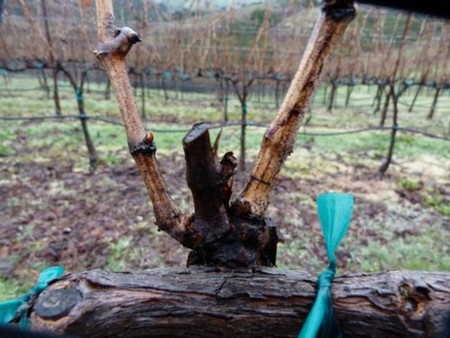
As you can see, two shoots grew from the spur position. This is our first and foremost form of growth control. We want to limit things to 10 Spur positions per vine, thus 20 shoots per vine. And since each shoot will typically only produce two clusters per shoot, we would have 40 clusters per vine in a perfect world. You never get that much fruit, but if left untended until harvest, that would be your max. It makes the fruit dropping that takes place at veraison much easier when pruned like this.
So how do you get the nice perfect two shoots of growth from each spur, well here is a handy photo to demonstrate.
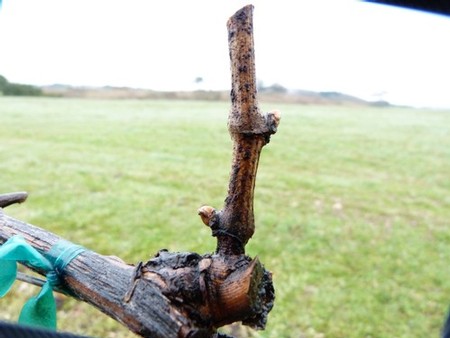
This is not an ideal spur here. The buds, the two white bumps, are too far from the cordon for my liking. But this photo nicely demonstrates the two buds per spur position pruning goal. Ideally, your buds will be really close to the cordon so that each year, the spur becomes a nice tight knot on the cordon. If you see a vine with spurs that are growing way away from the cordon, you got some lazy pruners, possible poor growth, and some angry grape pickers during harvest.
Here is what happens when you let your wine maker learn pruning the previous year.
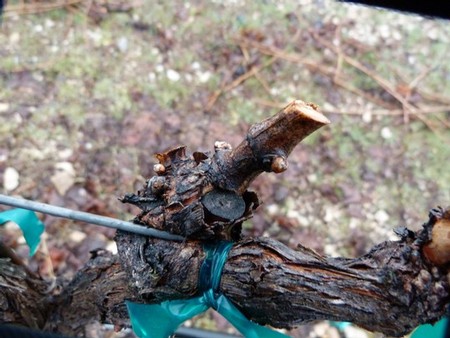
An ugly mess with buds all over the place. Now we will have to come back after bud break and knock off all the excess shoot growth. I let Martin handle this one this year, and he already did a great job of getting it under control. After pruning next year, that spur position will be beautiful.
In my humble opinion it can not be overstated how important vineyard practices like pruning are in determining the final product, the wine. With each cut, we are impacting how the vine will grow, how it will produce fruit, and how healthy it will be. It is a common throw away line in wine maker bios about how “the best wine is made in the vineyard”. This is what is meant by that. Pruning is a back breaking, hand killing endeavor that needs to be carried out as carefully as any sorting, punch down or pressing that happens during harvest. When done correctly with proper care, the foundation for great wine is laid.
The most commonly asked question of our tasting room staff or to me while I am at events is, "What's the deal with the name Calcareous?" Well, maybe not exactly phrased like that, but you get the picture. The quick answer is that we have Calcareous soils here which means they are limestone-based. But the point of this blog is to be able to dig a bit deeper into these questions.
Many of the world's great wine growing regions are located above limestone deposits. Famed regions of France such as Châteauneuf-du-Pâpe, Saint Emilion, Alsace, and Burgundy all share the quality of having limestone soils. The reason limestone seems to be abundant in these great wine regions has been the subject of much debate and thorough research. The easy answer that the chalk imparts unique flavors or minerality to wine has been mostly rejected. There is however hard science proving that high pH, calcium rich soils do have a unique impact upon Vitis vinifera. For the sake of keeping this post somewhat managable, I won't go into all of that here. But if you are the inquiring type that enjoys bringing a bit of wine science to the dinner table or your next tasting, here are some resources. This primer by Valerie Saxton printed in the Wine Business Monthly is a great article for the scientifically inclined. Our neighbor and king of Paso Robles wine bloggers Jason Hass at Tablas Creek, took that info and summarized how it plays out here in Paso Robles.
So, with all that being said, if we dare call ourselves Calcareous, we better produce the limestone to back it up. So my assistant winemaker, two dogs and I went out into the vineyard on a hunt for this magical stone. One thing you'll notice walking around our vineyard, or even while driving the windy roads of West Paso, there are quite a few white chalky looking rocks laying around. My first inclination as a winemaker and lazy geologist was to point out to visitors, "Hark, behold the wonder of limestone!"
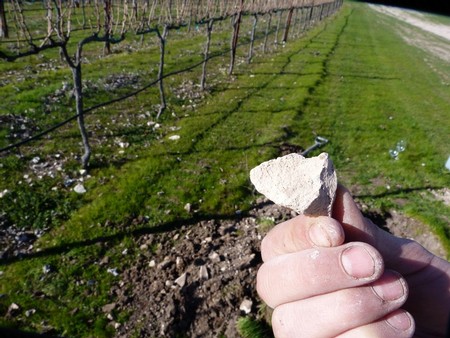
Well, sadly, one day a few years ago, an actual geologist was in one of my tour groups. There was a bit of snickering when I picked up my "limestone" and passed it around. Oh the sad comedy of the "know-it-all" winemaker getting called out by the scientist! What I was passing off as limestone was actually shale. I wasn’t way off the mark as it was shale that had some calcite amongst the clay. That's nice, but I wanted outright pure limestone bedrock here to make other vineyards jealous. We're Calcareous for pete's sake! My new scientist buddy told me if I had pure limestone, you would be able drop it in a strong acid and--boom--Carbon Dioxide will come bubbling forth. Sure, vinegar or even our Chardonnay has enough acid to make some slow bubbles, but that's not impressive enough. So, grabbing some Hydrochloric Acid from the wine lab, we put our rocks to the test. If you place that chunk of shale into the glass, pretty boring.
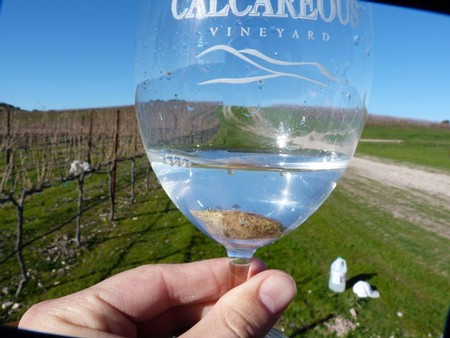
Nothing there to impress a viticulture geek, let alone any ladies on the tour. So we needed to find some of the good stuff. Que the shovels and the digging. Removing a couple feet of dark rich top soil and more chunks of shale had me feeling like Geraldo opening Al Capone's vault. But if you need to dig through a couple of meters of stone and clay at Chateau de Beaucastel to reach limestone, we had to keep going. Then, just a couple inches more and a new texture appeared. A soft, crumbly grayish rock-was this what we were seeking?

There's one fun way to find out, drop it in the glass of acid.
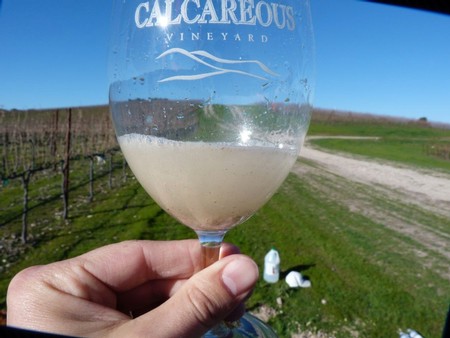
BINGO! And there was much rejoicing. So much excitement actually, we made the ill-fated decision to film me putting rocks into a glass. And the Internets are now richer for it.
So yes, we have limestone, and yes we are abundantly Calcareous. Great, why should any of you care? I know I promised not to go into this for brevity’s sake, but we’ve come this far. If you're still here, you deserve something. From my own personal experience, I have a few reasons to believe having limestone bedrock only a few feet below the surface makes our vineyard incredible. The first thing I have noticed is that we rarely have to drop fruit here. The vines are extremely non-vigorous in either vegetal growth or fruit set. We naturally only produce about 2 tons/acre of fruit. We had a bumper crop this year which netted 38 tons from our 18 acres of vines. What little fruit we do get is of astonishing intensity. The color, tannins, and flavors extracted from fruit here rivals any other fruit I have tasted.
Secondly, if you read any of the sources linked above, you will learn that high levels of acidity are maintained in fruit grown on limestone soils. We achieve wonderful levels of ripeness in our fruit yet maintain pH levels from 3.1-3.5 in all the varietals grown here. This gives us the great necessity of big, fully extracted, ripe wines to be truly palatable:balance. Sure, you can dump a bunch of factory made tartaric-acid in your overly ripe grapes to bring the pH down to where you want. But that can not, and will not replace the flavor of natural grape acids. Natural perfection can not be imitated. Thus from this world-class vineyard, where pure limestone is just a scratch below the surface, we are producing world-class wines.
-Jason